人教版(2019)高中英语选择性必修第三册 Unit5 Poems Reading and Thinking 名师教学设计1
文档属性
| 名称 | 人教版(2019)高中英语选择性必修第三册 Unit5 Poems Reading and Thinking 名师教学设计1 | 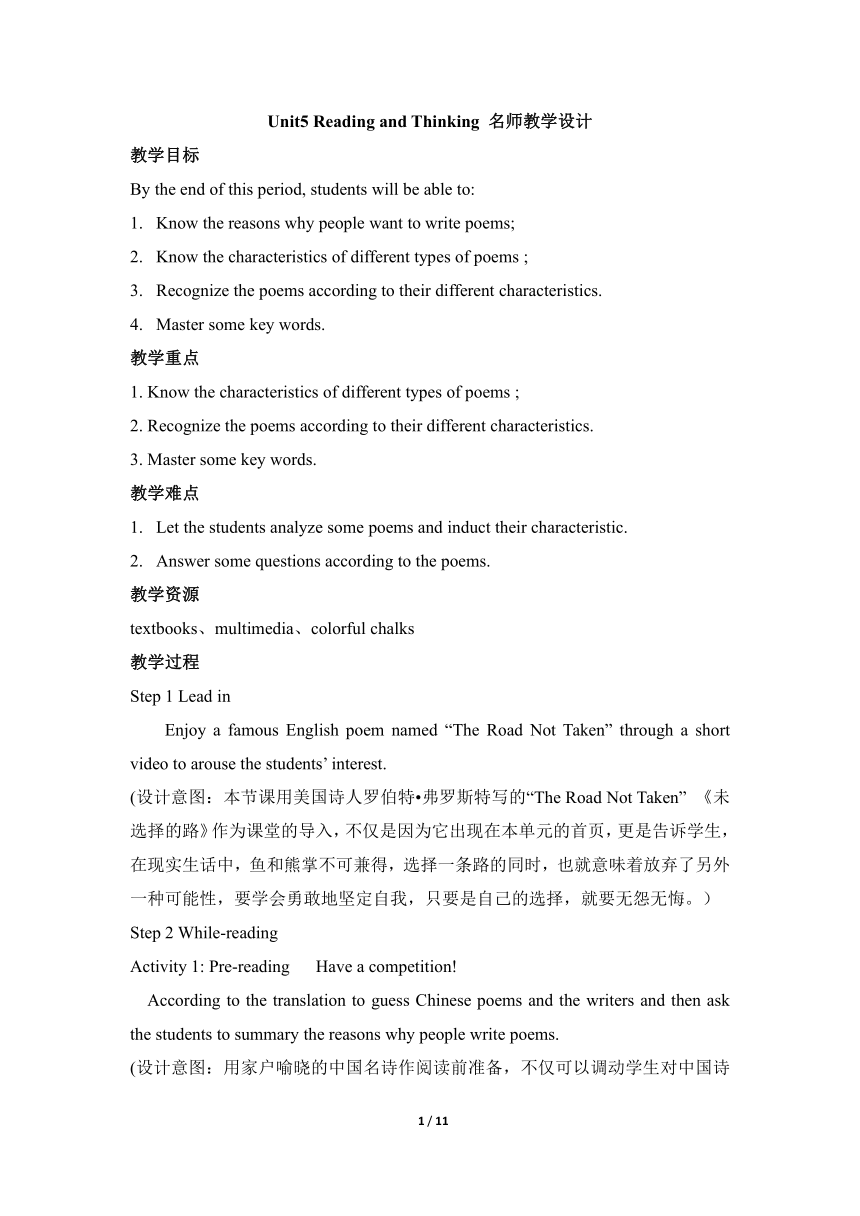 | |
| 格式 | docx | ||
| 文件大小 | 23.5KB | ||
| 资源类型 | 教案 | ||
| 版本资源 | 人教版(2019) | ||
| 科目 | 英语 | ||
| 更新时间 | 2023-03-13 22:35:02 | ||
图片预览

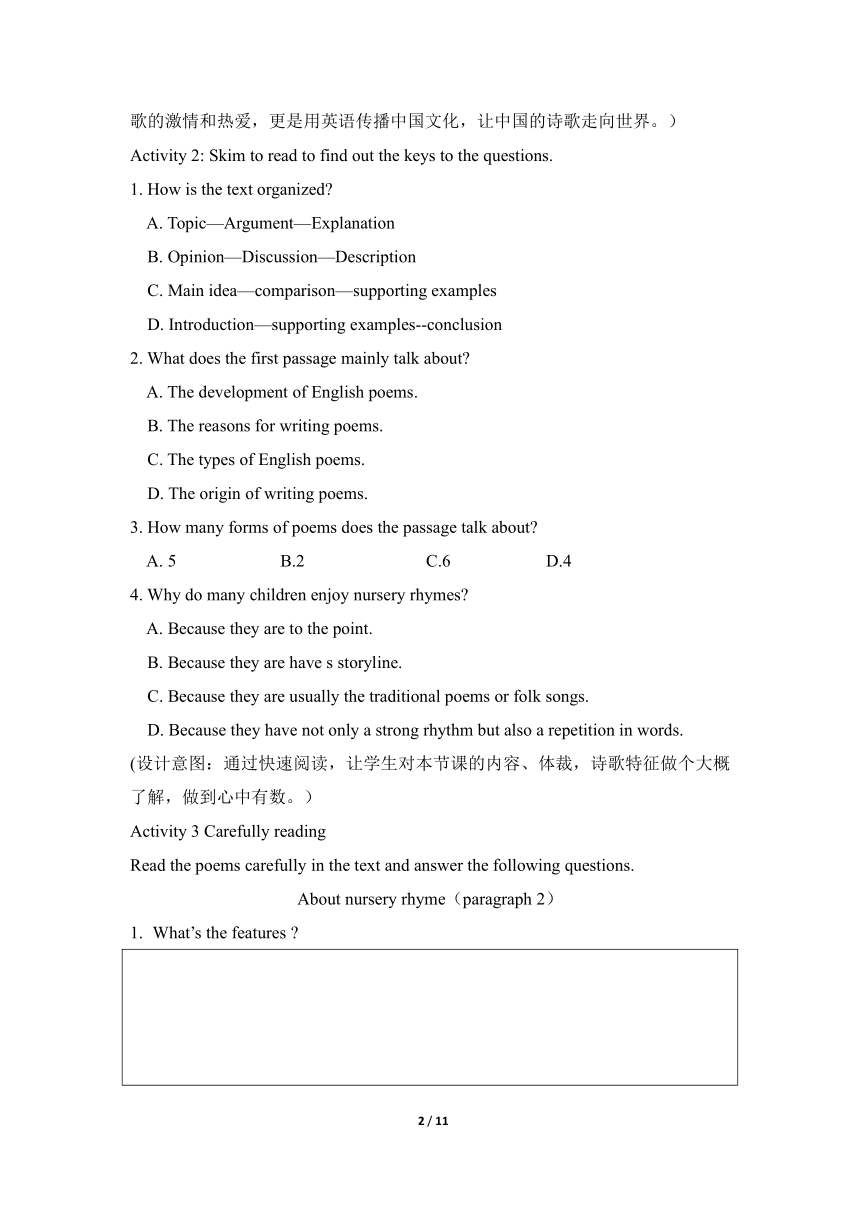
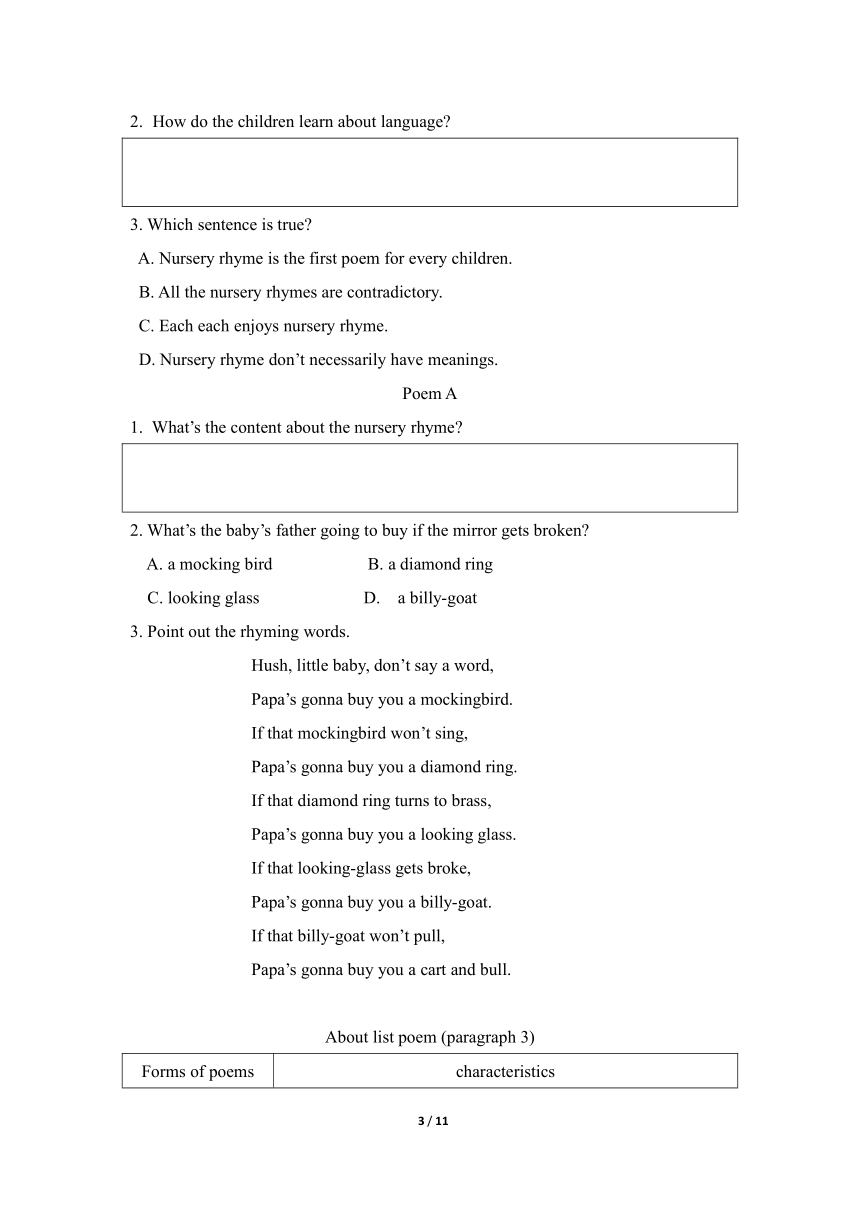
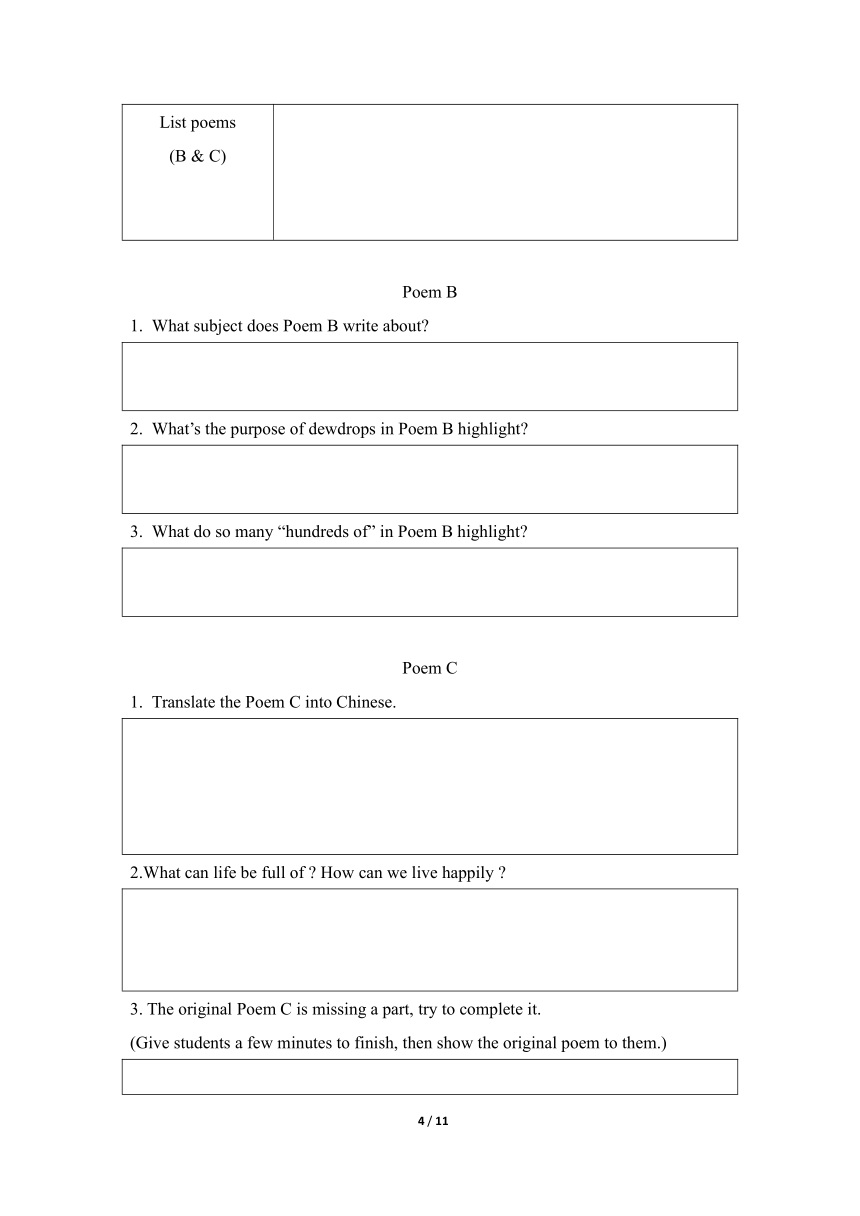
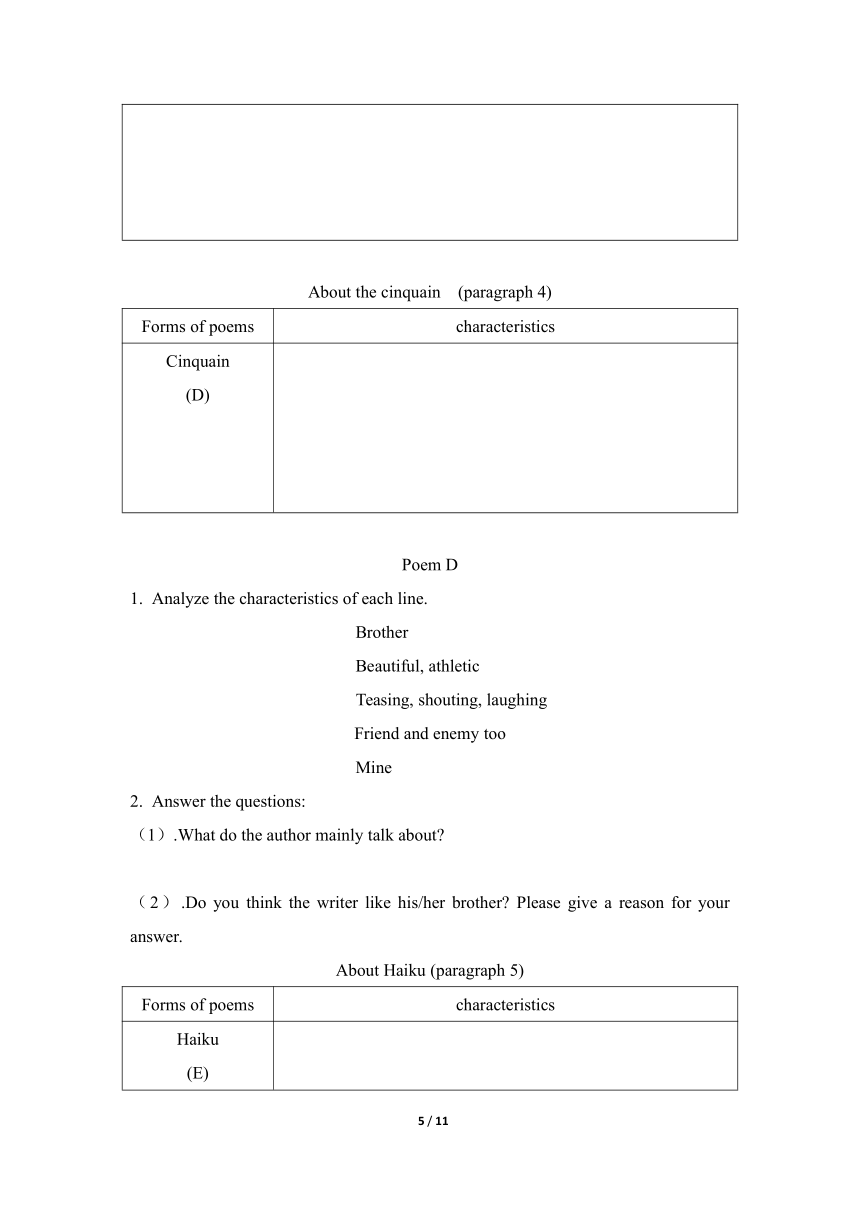
文档简介
Unit5 Reading and Thinking 名师教学设计
教学目标
By the end of this period, students will be able to:
Know the reasons why people want to write poems;
Know the characteristics of different types of poems ;
Recognize the poems according to their different characteristics.
Master some key words.
教学重点
1. Know the characteristics of different types of poems ;
2. Recognize the poems according to their different characteristics.
3. Master some key words.
教学难点
Let the students analyze some poems and induct their characteristic.
Answer some questions according to the poems.
教学资源
textbooks、multimedia、colorful chalks
教学过程
Step 1 Lead in
Enjoy a famous English poem named “The Road Not Taken” through a short video to arouse the students’ interest.
(设计意图:本节课用美国诗人罗伯特 弗罗斯特写的“The Road Not Taken” 《未选择的路》作为课堂的导入,不仅是因为它出现在本单元的首页,更是告诉学生,在现实生话中,鱼和熊掌不可兼得,选择一条路的同时,也就意味着放弃了另外一种可能性,要学会勇敢地坚定自我,只要是自己的选择,就要无怨无悔。)
Step 2 While-reading
Activity 1: Pre-reading Have a competition!
According to the translation to guess Chinese poems and the writers and then ask the students to summary the reasons why people write poems.
(设计意图:用家户喻晓的中国名诗作阅读前准备,不仅可以调动学生对中国诗歌的激情和热爱,更是用英语传播中国文化,让中国的诗歌走向世界。)
Activity 2: Skim to read to find out the keys to the questions.
1. How is the text organized
A. Topic—Argument—Explanation
B. Opinion—Discussion—Description
C. Main idea—comparison—supporting examples
D. Introduction—supporting examples--conclusion
2. What does the first passage mainly talk about
A. The development of English poems.
B. The reasons for writing poems.
C. The types of English poems.
D. The origin of writing poems.
3. How many forms of poems does the passage talk about
A. 5 B.2 C.6 D.4
4. Why do many children enjoy nursery rhymes
A. Because they are to the point.
B. Because they are have s storyline.
C. Because they are usually the traditional poems or folk songs.
D. Because they have not only a strong rhythm but also a repetition in words.
(设计意图:通过快速阅读,让学生对本节课的内容、体裁,诗歌特征做个大概了解,做到心中有数。)
Activity 3 Carefully reading
Read the poems carefully in the text and answer the following questions.
About nursery rhyme(paragraph 2)
What’s the features
How do the children learn about language
3. Which sentence is true
A. Nursery rhyme is the first poem for every children.
B. All the nursery rhymes are contradictory.
C. Each each enjoys nursery rhyme.
D. Nursery rhyme don’t necessarily have meanings.
Poem A
What’s the content about the nursery rhyme
2. What’s the baby’s father going to buy if the mirror gets broken
A. a mocking bird B. a diamond ring
C. looking glass D. a billy-goat
3. Point out the rhyming words.
Hush, little baby, don’t say a word,
Papa’s gonna buy you a mockingbird.
If that mockingbird won’t sing,
Papa’s gonna buy you a diamond ring.
If that diamond ring turns to brass,
Papa’s gonna buy you a looking glass.
If that looking-glass gets broke,
Papa’s gonna buy you a billy-goat.
If that billy-goat won’t pull,
Papa’s gonna buy you a cart and bull.
About list poem (paragraph 3)
Forms of poems characteristics
List poems (B & C)
Poem B
What subject does Poem B write about
What’s the purpose of dewdrops in Poem B highlight
What do so many “hundreds of” in Poem B highlight
Poem C
Translate the Poem C into Chinese.
2.What can life be full of How can we live happily
3. The original Poem C is missing a part, try to complete it.
(Give students a few minutes to finish, then show the original poem to them.)
About the cinquain (paragraph 4)
Forms of poems characteristics
Cinquain (D)
Poem D
Analyze the characteristics of each line.
Brother
Beautiful, athletic
Teasing, shouting, laughing
Friend and enemy too
Mine
Answer the questions:
(1).What do the author mainly talk about
(2).Do you think the writer like his/her brother Please give a reason for your answer.
About Haiku (paragraph 5)
Forms of poems characteristics
Haiku (E)
Poem E
Please mark out the 17 syllables of Haiku E.
A fallen blossom
Is coming back to the branch.
Look, a butterfly!
Choose the best answer
(1). What was it that fell on the branch
A. a fallen blossom B. a dead leaf
C. a delicate butterfly D. a happy bird
(2). Which sentence is true
A. Haiku originates from Europe.
B. Haiku is popular with Japanese writers.
C. Haiku is a traditional form of Japanese poetry with 17 rhythms.
D. Haiku show a clear picture and convey a special feelings.
Poem F
1. What are the feelings of the woman from Poem F
2. What rhetorical device (修辞手法) is used in the sentence “This stone would utter
speech”
3.Which phrase in this poem conveys the same meaning as “Wind and rain revolve”
(设计意图:通过不同的问题设计,让学生掌握每种诗歌的特点。)
Step 3 Post-reading
Activity 4: To put into practice what has been learned(学以致用)
To judge which type the poems belong to
1.
Summer
Sleepy, salty
Drying, drooping, dreading
Week in, week out
Endless
2.
I saw a fish-pond all on fire
I saw a fish-pond all on fire,
I saw a house bow to a squire,
I saw a person twelve-feet high,
I saw a cottage in the sky,
I saw a balloon made of lead,
I saw a coffin drop down dead,
I saw two sparrows run a race,
I saw two horses making lace,
I saw g girl just like a cat,
I saw a kitten wear a hat,
I saw a man who saw these too,
And said though strange they all were true.
Snow having melted,
The whole village is brimful
Of happy children.
(by Issa)
4.
HOME-COMING
Old, I return to the homeland while young,
Thinner has grown my hair, though I speak the same tongue.
My children, whom I meet, do not know am I,
“Where are you from, dear sir ” they ask with beaming eyes.
5.
Bye, baby bunting,
Daddy’s gone a-hunting,
Gone to get a rabbit skin
To wrap the baby bunting in.
6.
A drizzling rain falls like tears on the Mourning Day;
The mourner's heart is going to break on his way.
Where can a wineshop be found to drown his sad hours
A cowherd points to a cot 'mid apicot flowers.
(设计意图:根据诗歌特点判断诗歌类型。此环节旨在考查学生掌握诗歌特点的情况。)
Activity 5 summary
语法填空(根据课文内容和语法规则完成短文)
There are a variety of reasons for people to write poems. In the text, five kinds of poems 1. (introduce). Some poems convey some certain emotions
2. the readers, such as well-being and sorrow; Some leave a deep
3. (impress) on the readers. What’s 4. , we learn about some characteristics of poetry through the text. Nursery rhymes seem
5. (contradict) and sometimes senseless, but they can help children learn about language. List poems have a flexible line length and 6. (repeat) phrases. Cinquain, 7. (make) up of five lines, conveys a strong picture or a certain mood . Haiku is a Japanese form of poetry 8. (consist)
of 17 syllables with only three lines. It isn’t a 9. (tradition) English, but English writers are attracted to it. English speakers appreciate Tang poetry as well. With so many different forms of poetry 10 (choose) from, students may eventually feel like composing poems of their own.
(设计意图:以完形填空的方式对本节课所学内容做出总结。)
Step 4 Vocabulary
Activity 6 核心词汇
compare【句子翻译】
(1). 我的书法不能与我父亲的相比。
(2). 莎士比亚把人世比做舞台。
(3). 与杭州相比上海大。
compose【句子翻译】
(1). 写一篇文章来表达你在这个话题上的观点。。
(2). 水由氢和氧组成。。
(3). 当迷失在森林中时,他迫使自己冷静下来想出一个好办法。
express【句子翻译】
(1). 我对他佩服得无法表达。
(2).他觉得很难用英语来表达自己的想法。
(3).这是一趟开往的上海的特快专列。
to the point【句子翻译】
(1). 他的评论总是切中要害。
(2). Noise is coming to the point where we can’t put up with it.
(3). 我希望你的发言直接了当。
make sense【句子翻译】
(1).他们试图明白这个乞丐在说什么。
(2).这部电影对学生来说很有意义。
(3).我们绝不允许这样的事情发生在学校。
while【句子翻译】
(1). 只要有空气和水,就会有生命。
(2). 他在玩电脑而弟弟在写作业。
(3). 虽然我能理解你说的话,但是我不能同意你.。
. 趁热打铁。
7. be made up of 【句子翻译】
(1). 这个书架是由木头制成的。
(2). "书店"一词是由"书"及"店"两字组成。。
(3). 这是一个由46个学生组成的班级。
(设计意图:熟悉并掌握本节课的重点词汇。)
Step 4: Homework
1. Review the characteristics of each kind of poem
2. Write a summary of about 60 words based on the text.
2 / 2
教学目标
By the end of this period, students will be able to:
Know the reasons why people want to write poems;
Know the characteristics of different types of poems ;
Recognize the poems according to their different characteristics.
Master some key words.
教学重点
1. Know the characteristics of different types of poems ;
2. Recognize the poems according to their different characteristics.
3. Master some key words.
教学难点
Let the students analyze some poems and induct their characteristic.
Answer some questions according to the poems.
教学资源
textbooks、multimedia、colorful chalks
教学过程
Step 1 Lead in
Enjoy a famous English poem named “The Road Not Taken” through a short video to arouse the students’ interest.
(设计意图:本节课用美国诗人罗伯特 弗罗斯特写的“The Road Not Taken” 《未选择的路》作为课堂的导入,不仅是因为它出现在本单元的首页,更是告诉学生,在现实生话中,鱼和熊掌不可兼得,选择一条路的同时,也就意味着放弃了另外一种可能性,要学会勇敢地坚定自我,只要是自己的选择,就要无怨无悔。)
Step 2 While-reading
Activity 1: Pre-reading Have a competition!
According to the translation to guess Chinese poems and the writers and then ask the students to summary the reasons why people write poems.
(设计意图:用家户喻晓的中国名诗作阅读前准备,不仅可以调动学生对中国诗歌的激情和热爱,更是用英语传播中国文化,让中国的诗歌走向世界。)
Activity 2: Skim to read to find out the keys to the questions.
1. How is the text organized
A. Topic—Argument—Explanation
B. Opinion—Discussion—Description
C. Main idea—comparison—supporting examples
D. Introduction—supporting examples--conclusion
2. What does the first passage mainly talk about
A. The development of English poems.
B. The reasons for writing poems.
C. The types of English poems.
D. The origin of writing poems.
3. How many forms of poems does the passage talk about
A. 5 B.2 C.6 D.4
4. Why do many children enjoy nursery rhymes
A. Because they are to the point.
B. Because they are have s storyline.
C. Because they are usually the traditional poems or folk songs.
D. Because they have not only a strong rhythm but also a repetition in words.
(设计意图:通过快速阅读,让学生对本节课的内容、体裁,诗歌特征做个大概了解,做到心中有数。)
Activity 3 Carefully reading
Read the poems carefully in the text and answer the following questions.
About nursery rhyme(paragraph 2)
What’s the features
How do the children learn about language
3. Which sentence is true
A. Nursery rhyme is the first poem for every children.
B. All the nursery rhymes are contradictory.
C. Each each enjoys nursery rhyme.
D. Nursery rhyme don’t necessarily have meanings.
Poem A
What’s the content about the nursery rhyme
2. What’s the baby’s father going to buy if the mirror gets broken
A. a mocking bird B. a diamond ring
C. looking glass D. a billy-goat
3. Point out the rhyming words.
Hush, little baby, don’t say a word,
Papa’s gonna buy you a mockingbird.
If that mockingbird won’t sing,
Papa’s gonna buy you a diamond ring.
If that diamond ring turns to brass,
Papa’s gonna buy you a looking glass.
If that looking-glass gets broke,
Papa’s gonna buy you a billy-goat.
If that billy-goat won’t pull,
Papa’s gonna buy you a cart and bull.
About list poem (paragraph 3)
Forms of poems characteristics
List poems (B & C)
Poem B
What subject does Poem B write about
What’s the purpose of dewdrops in Poem B highlight
What do so many “hundreds of” in Poem B highlight
Poem C
Translate the Poem C into Chinese.
2.What can life be full of How can we live happily
3. The original Poem C is missing a part, try to complete it.
(Give students a few minutes to finish, then show the original poem to them.)
About the cinquain (paragraph 4)
Forms of poems characteristics
Cinquain (D)
Poem D
Analyze the characteristics of each line.
Brother
Beautiful, athletic
Teasing, shouting, laughing
Friend and enemy too
Mine
Answer the questions:
(1).What do the author mainly talk about
(2).Do you think the writer like his/her brother Please give a reason for your answer.
About Haiku (paragraph 5)
Forms of poems characteristics
Haiku (E)
Poem E
Please mark out the 17 syllables of Haiku E.
A fallen blossom
Is coming back to the branch.
Look, a butterfly!
Choose the best answer
(1). What was it that fell on the branch
A. a fallen blossom B. a dead leaf
C. a delicate butterfly D. a happy bird
(2). Which sentence is true
A. Haiku originates from Europe.
B. Haiku is popular with Japanese writers.
C. Haiku is a traditional form of Japanese poetry with 17 rhythms.
D. Haiku show a clear picture and convey a special feelings.
Poem F
1. What are the feelings of the woman from Poem F
2. What rhetorical device (修辞手法) is used in the sentence “This stone would utter
speech”
3.Which phrase in this poem conveys the same meaning as “Wind and rain revolve”
(设计意图:通过不同的问题设计,让学生掌握每种诗歌的特点。)
Step 3 Post-reading
Activity 4: To put into practice what has been learned(学以致用)
To judge which type the poems belong to
1.
Summer
Sleepy, salty
Drying, drooping, dreading
Week in, week out
Endless
2.
I saw a fish-pond all on fire
I saw a fish-pond all on fire,
I saw a house bow to a squire,
I saw a person twelve-feet high,
I saw a cottage in the sky,
I saw a balloon made of lead,
I saw a coffin drop down dead,
I saw two sparrows run a race,
I saw two horses making lace,
I saw g girl just like a cat,
I saw a kitten wear a hat,
I saw a man who saw these too,
And said though strange they all were true.
Snow having melted,
The whole village is brimful
Of happy children.
(by Issa)
4.
HOME-COMING
Old, I return to the homeland while young,
Thinner has grown my hair, though I speak the same tongue.
My children, whom I meet, do not know am I,
“Where are you from, dear sir ” they ask with beaming eyes.
5.
Bye, baby bunting,
Daddy’s gone a-hunting,
Gone to get a rabbit skin
To wrap the baby bunting in.
6.
A drizzling rain falls like tears on the Mourning Day;
The mourner's heart is going to break on his way.
Where can a wineshop be found to drown his sad hours
A cowherd points to a cot 'mid apicot flowers.
(设计意图:根据诗歌特点判断诗歌类型。此环节旨在考查学生掌握诗歌特点的情况。)
Activity 5 summary
语法填空(根据课文内容和语法规则完成短文)
There are a variety of reasons for people to write poems. In the text, five kinds of poems 1. (introduce). Some poems convey some certain emotions
2. the readers, such as well-being and sorrow; Some leave a deep
3. (impress) on the readers. What’s 4. , we learn about some characteristics of poetry through the text. Nursery rhymes seem
5. (contradict) and sometimes senseless, but they can help children learn about language. List poems have a flexible line length and 6. (repeat) phrases. Cinquain, 7. (make) up of five lines, conveys a strong picture or a certain mood . Haiku is a Japanese form of poetry 8. (consist)
of 17 syllables with only three lines. It isn’t a 9. (tradition) English, but English writers are attracted to it. English speakers appreciate Tang poetry as well. With so many different forms of poetry 10 (choose) from, students may eventually feel like composing poems of their own.
(设计意图:以完形填空的方式对本节课所学内容做出总结。)
Step 4 Vocabulary
Activity 6 核心词汇
compare【句子翻译】
(1). 我的书法不能与我父亲的相比。
(2). 莎士比亚把人世比做舞台。
(3). 与杭州相比上海大。
compose【句子翻译】
(1). 写一篇文章来表达你在这个话题上的观点。。
(2). 水由氢和氧组成。。
(3). 当迷失在森林中时,他迫使自己冷静下来想出一个好办法。
express【句子翻译】
(1). 我对他佩服得无法表达。
(2).他觉得很难用英语来表达自己的想法。
(3).这是一趟开往的上海的特快专列。
to the point【句子翻译】
(1). 他的评论总是切中要害。
(2). Noise is coming to the point where we can’t put up with it.
(3). 我希望你的发言直接了当。
make sense【句子翻译】
(1).他们试图明白这个乞丐在说什么。
(2).这部电影对学生来说很有意义。
(3).我们绝不允许这样的事情发生在学校。
while【句子翻译】
(1). 只要有空气和水,就会有生命。
(2). 他在玩电脑而弟弟在写作业。
(3). 虽然我能理解你说的话,但是我不能同意你.。
. 趁热打铁。
7. be made up of 【句子翻译】
(1). 这个书架是由木头制成的。
(2). "书店"一词是由"书"及"店"两字组成。。
(3). 这是一个由46个学生组成的班级。
(设计意图:熟悉并掌握本节课的重点词汇。)
Step 4: Homework
1. Review the characteristics of each kind of poem
2. Write a summary of about 60 words based on the text.
2 / 2
